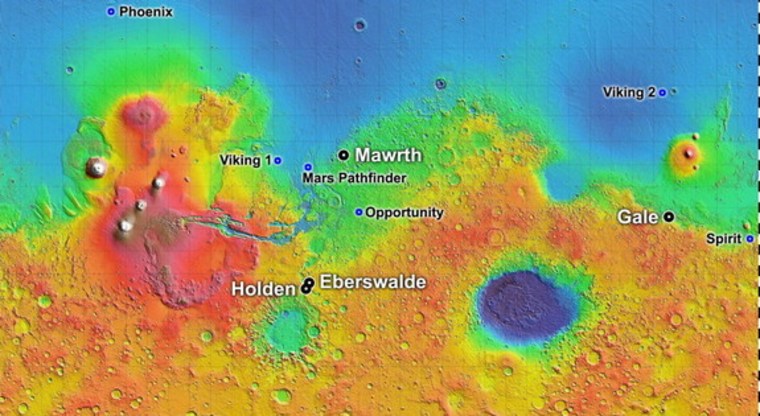NASA has whittled the possible landing sites for its next Mars rover down to two, scientists announced Wednesday.
The Mars Science Laboratory (MSL) mission will drop a car-size rover named Curiosity down to the Red Planet's surface at one of two craters: Gale or Eberswalde. Both sites have a lot going for them, and picking a winner will be tough, scientists said.
"We are thrilled to go to either one of these landing sites," John Grotzinger, MSL project scientist at Caltech in Pasadena, Calif., said after a press conference here at NASA's Kennedy Space Center. "It's like two different flavors of ice cream — do you like chocolate or vanilla on Mars? So we go back and forth a lot."
A final decision on Curiosity's destination will likely be made by the end of the month, Grotzinger added.
From four to two
Last year, NASA announced that it had chosen four possible landing sites for Curiosity. In addition to Gale and Eberswalde, the options included another crater named Holden and an apparent flood channel known as Mawrth Vallis.
All four were intriguing, presenting lots of evidence of ancient water activity on Mars, Grotzinger said. Curiosity's main task is to assess whether Mars is — or ever was — capable of supporting microbial life, so it needs to look in spots where liquid water once flowed (Mars' surface appears to be bone-dry today).
Scientists think Eberswalde is an ancient river delta. While Holden is similar in many ways, containing gullies and other features carved by running water long ago, it lost out by a hair.
"Eberswalde has one or two extra attributes that set it apart," Grotzinger said.
Mawrth Vallis was ultimately axed in part because researchers don't think they understand its geologic history as well as they know Gale's.
"It's really hard to understand the context of what's going on there," Grotzinger said of Mawrth Vallis. "There were just a lot more question marks."
Gale Crater is a standout choice on its own merits. A mountain nearly 3 miles high rises from its center. If Curiosity ultimately goes to Gale, the rover will chug partway up this mountain, analyzing the many different rock layers it encounters along the way.
"Those are chapters in the history of the environmental evolution of Mars," Grotzinger said.
The sky crane
Curiosity is much larger than any previous Mars rover; it's the size of a Mini Cooper and weighs about a ton. The rover's heft necessitated the development of an entirely new system to deliver it to the Martian surface.
The solution NASA engineers came up with is a rocket-powered sky crane that will hover over the Red Planet, then lower Curiosity down to the surface with cables. This system is entirely novel, but mission engineers have said they are confident it will work.
The sky crane will allow Curiosity to make a much more precise landing than previous Mars rovers could pull off. Curiosity's landing ellipse should be about 12 miles by 14 miles, Grotzinger said. When the twin rovers Spirit and Opportunity landed on Mars in 2004, by contrast, their landing ellipses were about 93 by 50 miles.
The sky crane's increased precision is a big asset, Grotzinger said. It allows MSL mission planners to choose a landing site based entirely on the science they want to perform, rather than go for a spot that is safe and flat (and thus probably relatively boring geologically).
The $2.5 billion MSL mission is slated to launch from Cape Canaveral toward the end of November and arrive at the Red Planet in August 2012. Once on the surface, Curiosity will investigate the Martian landscape in detail with a suite of 10 different instruments.
You can follow Space.com senior writer Mike Wall on Twitter: @michaeldwall. Follow Space.com for the latest in space science and exploration news on Twitter @Spacedotcom and on Facebook.
